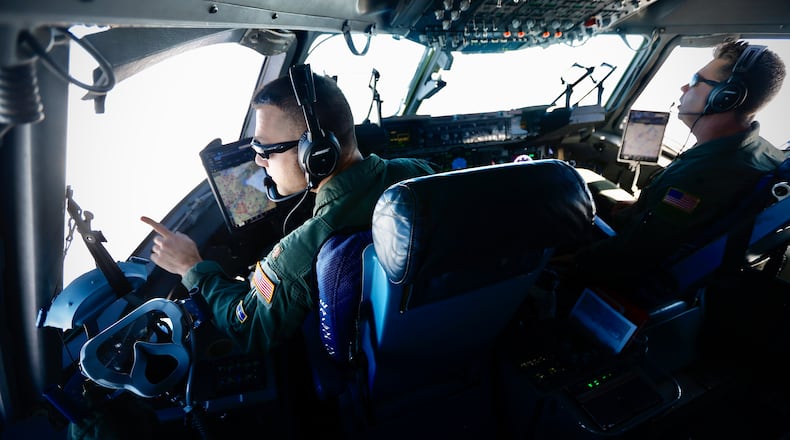“That’s what we tell our reservists every day: Be ready,” said Col. Mike Baker, operations group commander at the 445th, a unit made up of members deployed (as of Sept. 30, the end of the federal government’s fiscal year) in Spain, Germany, Saudi Arabia and Qatar.
This Air Force Reserve Command unit flies nine Boeing C-17 Globemaster IIIs — big, gunship grey and nimble.
A typical civilian airliner landing at Dayton International Airport may need a runway 7,000 to 9,000 feet in length. But the mighty C-17 needs only 3,500 feet of runway, about 90 feet wide. And if pressed into a tactical landing, it can be put down in a 500-by-90-foot box, descending on a five-degree glide path, starkly different than the three-degree approach a civilian plane typically uses.
Normally, when planes go slow, bad things happen, Baker said. But in the hands of skilled pilots, the C-17 thrives in those situations, its flaps extending into the exhaust streams from its quartet of Pratt & Whitney F117-PW-100 engines.
And pilots for the 445th need to be ready to do all of that tonight, if necessary, though many of them fly for the Reserve part-time. They train all year to acquire and refine the necessary skills.
As capable as the pilots are, Baker in an interview paused to praise the unit’s medical personnel. The 445th’s medical units include an Aerospace Medicine Squadron with 86 members and an Aeromedical Staging Squadron with 139 members.
All are ready to transport wounded and sick people from battlefields to military hospitals at a moment’s notice.
“These people are amazing at the back of the plane,” Baker said. “They turn it into a flying hospital.”
This past January, about 140 members of the wing returned from a deployment at an undisclosed location. Members declined to say where they worked or what their precise work was.
But the wing did acknowledge that one of its C-17s transported supplies destined for Gaza in late November 2023, not long after Hamas militants launched an attack against Israel on Oct. 7, igniting a new war.
“What happens in the world impacts us,” Baker said. “And that’s what we signed up for.”
Taking flight
The 445th was activated at Wright-Patterson when two former units combined: the 906th Fighter Group from Wright-Patterson and the 907th Tactical Airlift Group from Rickenbacker Air National Guard Base, which were deactivated Sept. 30, 1994.
The 445th stays busy. In fiscal year 2022, it flew more missions than any other Air Force Reserve Command unit equipped with C-17s.
The wing flew 248 missions in fiscal 2024, moving more than 5,800 passengers and more than 18.3 million pounds of cargo. Today, the command is flying missions to and from Bahrain, Australia, the U.S. Africa Command area of responsibility and Kwajalein, an island in the southern Pacific Ocean.
Maj. Nate Copen, a flight nurse who has worked for Premier Health and Kettering Health in the Dayton area, loves the job.
“It’s quite a balance,” said Copen, who has worked for the unit for eight years. “You have to balance your family, your civilian career and this military career. It’s a very high tempo. But our wing supports all of its members.”
When you love your job, you’ll never work a day in your life, he added, citing an age-old observation.
“This is the best job I’ve ever had as a nurse,” he said. “I’m very fortunate. I was not aware of this job until later in my career as a nurse. And once I found out about it, I put everything to the side and I did it.”
He added, “My only regret is not joining sooner. I love it.”
About the Author




